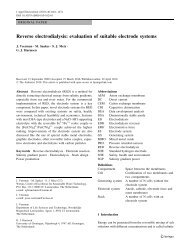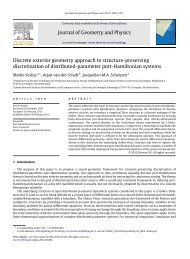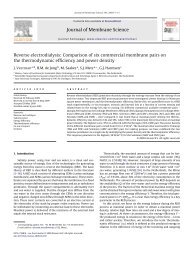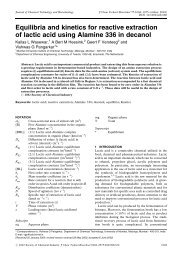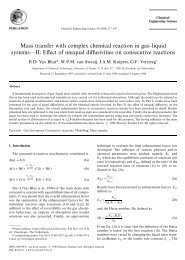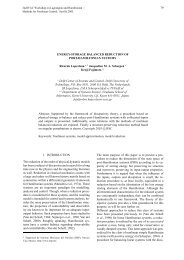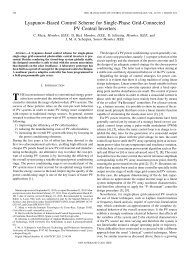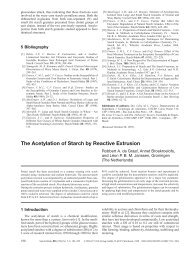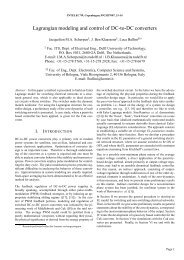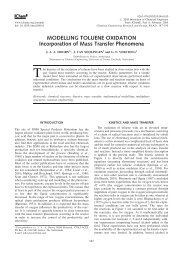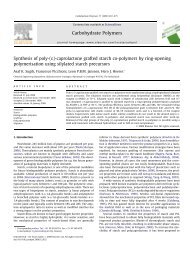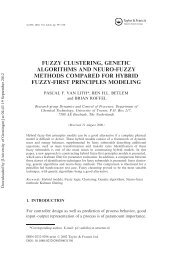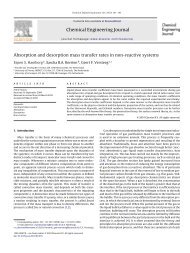Mass transfer with complex chemical reaction in gas—liquid ... - ITM
Mass transfer with complex chemical reaction in gas—liquid ... - ITM
Mass transfer with complex chemical reaction in gas—liquid ... - ITM
You also want an ePaper? Increase the reach of your titles
YUMPU automatically turns print PDFs into web optimized ePapers that Google loves.
124 R.D. Vas Bhat et al./Chemical Eng<strong>in</strong>eer<strong>in</strong>g Science 54 (1999) 121—136Table 2Reaction stoichiometries considered for the validation of the numerical code together <strong>with</strong> the maximum and average deviations found <strong>in</strong> thenumerical computationsCase K<strong>in</strong>etic Maximum Average Number of Validation literatureexpression deviation (%) deviation (%) po<strong>in</strong>tsFirst-order irreversible k A 0.73 0.11 24 Higbie (1935)Second-order irreversible k AB 3.72 0.94 24 DeCoursey (1974)Yeramian et al. (1970)Second-order reversible k AB!k CD 5.36 1.67 80 DeCoursey and Thr<strong>in</strong>g (1989) Second-order reversible k AB!k CD 5.90 1.0 124 DeCoursey and Thr<strong>in</strong>g (1989) <strong>with</strong> unequal diffusivities D OD Second-order reversible k AB!k CD 6.00 2.1 144 DeCoursey and Thr<strong>in</strong>g (1989) <strong>with</strong> loaded solutions A "αB Deviation def<strong>in</strong>ed as: dev" E !E 100 .E EAverage deviation is def<strong>in</strong>ed as: avgdev" Number of po<strong>in</strong>ts .code used for the mass <strong>transfer</strong> flux calculations <strong>with</strong>consecutive <strong>chemical</strong> <strong>reaction</strong>.4. Consecutive <strong>reaction</strong>s4.1. Both <strong>reaction</strong>s irreversibleThe simplest form of consecutive <strong>reaction</strong>s <strong>with</strong> unitstoichiometric and k<strong>in</strong>etic orders has been studied earlierby Onda and co-workers (1970, 1972). The same systemwas numerically <strong>in</strong>vestigated by Huang et al. (1980).Results obta<strong>in</strong>ed from simulations, carried out <strong>with</strong>the model described <strong>in</strong> this paper, are presented <strong>in</strong> Fig.1(a) as enhancement factor, E , def<strong>in</strong>ed asE "N (6a) k (A !A ) which is the ratio of <strong>chemical</strong> to physical flux underidentical concentration driv<strong>in</strong>g force, over a range ofHatta numbers, Ha, def<strong>in</strong>ed asHa" k B D . (6b)k From Eq. (6b), it is clear that the Hatta number, used <strong>in</strong>this study, is def<strong>in</strong>ed on the basis of the first <strong>reaction</strong> (1b).The Hatta numbers were varied by chang<strong>in</strong>g, either theliquid mass <strong>transfer</strong> coefficient, k , or the k<strong>in</strong>etic rateconstants. The vary<strong>in</strong>g parameter <strong>in</strong> the graph, K ,is def<strong>in</strong>ed as the ratio of the forward rate constantsK " k .(6c) k The follow<strong>in</strong>g po<strong>in</strong>ts need to be noted:(a) The <strong>reaction</strong>s show a characteristic two-step <strong>in</strong>crease<strong>in</strong> the enhancement factor. Each step can be seenas a contribution by the <strong>in</strong>dividual <strong>reaction</strong>s to the totalenhancement. If <strong>reaction</strong> (1c) is slower than <strong>reaction</strong> (1b),then, at lower Ha, the absorption of A is determ<strong>in</strong>ed by<strong>reaction</strong> (1b) only. Consequently, the enhancement factor<strong>in</strong>creases, as is observed for a s<strong>in</strong>gle irreversible <strong>reaction</strong>,to its asymptotic value called the <strong>in</strong>termediate asymptoticenhancement factor (E ). However, at higher Ha, sufficient<strong>in</strong>termediate C is produced <strong>with</strong><strong>in</strong> the penetrationdepth so that <strong>reaction</strong> (1c) can also <strong>in</strong>fluence the absorptionof A. As a result, the enhancement factor further<strong>in</strong>creases from the <strong>in</strong>termediate asymptotic value (E )to its f<strong>in</strong>al value. This value has been called the f<strong>in</strong>al<strong>in</strong>f<strong>in</strong>ite enhancement factor (E ). In addition, the po<strong>in</strong>t atwhich one observes the additional enhancement providedby the second <strong>reaction</strong> has been def<strong>in</strong>ed as the‘kick-<strong>in</strong>’ po<strong>in</strong>t. A typical ‘kick-<strong>in</strong>’ po<strong>in</strong>t for one case (K "10) is shown <strong>in</strong> Fig. 1(a).(b) At extremely high Ha (Ha'10), both <strong>reaction</strong>s(1b) and (1c) are <strong>in</strong>stantaneous <strong>with</strong> respect to mass<strong>transfer</strong>. Under these conditions the overall <strong>reaction</strong>scheme simplifies to:2A(l)#B(l) P D(l)#E(l)#F(l). (7)The <strong>in</strong>f<strong>in</strong>ite enhancement factor E , for the stoichiometrygiven above and equal diffusivities, is def<strong>in</strong>edasE "1# 2B A . (8)It is observed that all <strong>reaction</strong>s, irrespective of K ,f<strong>in</strong>ally converge to the same E .(c) The value of K is <strong>in</strong>dicative of the reactivity ofthe <strong>in</strong>termediate C <strong>with</strong> A. At very low values ofK (typically 10), the <strong>reaction</strong> between A and C isnoticeable only at very high Hatta numbers. For sucha case, a clear <strong>in</strong>termediate asymptotic enhancement



